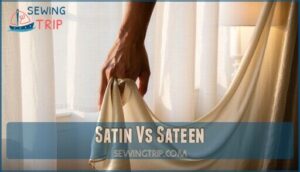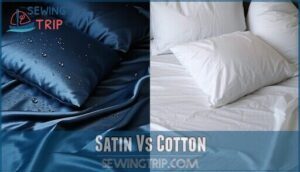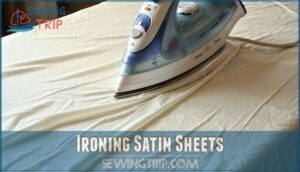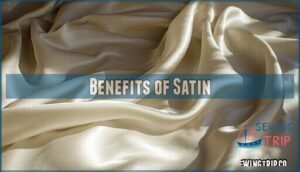This site is supported by our readers. We may earn a commission, at no cost to you, if you purchase through links.
 Yes, satin can make you sweat.
Yes, satin can make you sweat.
Despite its luxurious feel, satin doesn’t breathe well because its tight weave traps heat against your skin.
You’ll notice this especially on warm nights when you might wake up feeling like you’re wrapped in a stylish sauna.
Unlike cotton or linen, satin has poor moisture-wicking properties, leaving perspiration lingering uncomfortably.
However, synthetic satins typically cause more sweating than natural silk satins, which offer slightly better temperature regulation.
The fabric’s smooth surface also creates less friction against your skin, which some find compensates for the extra warmth.
Stick around to discover which satin blends might keep you cooler and offer better comfort with their unique properties.
Table Of Contents
Key Takeaways
- Satin tends to make you sweat because its tight weave traps heat against your skin and has poor moisture-wicking properties, creating a warm microclimate that can disrupt comfortable sleep.
- You’ll find that natural silk satins offer better temperature regulation than synthetic satins, though all satin fabrics initially feel cool to the touch before potentially warming up.
- Despite its breathability limitations, you’ll benefit from satin’s smooth surface which reduces friction against your skin and hair, preventing tangles and sleep wrinkles while also being hypoallergenic.
- You can mitigate satin’s heat retention by choosing lighter colors, looser styles that allow better air circulation, or opting for silk-satin blends that balance luxury with better breathability.
What is Satin
Satin isn’t a type of fabric; it’s a weaving technique that creates a smooth, shiny surface on materials like silk, polyester, or nylon.
This sleek finish gives it a luxurious feel, but it also affects its breathability and comfort.
Satin Fabric Overview
Satin’s charm lies in its glossy sheen and smooth texture, achieved through a unique weaving technique.
Made from fibers like polyester, silk, or nylon, modern satin offers durability and elegance.
However, while satin fabric feels luxurious, its tight weave impacts breathability, which might contribute to discomfort or satin fabric sweat.
Satin Characteristics
The satin weave creates a glossy surface sheen and soft drape quality, making satin visually stunning and smooth to the touch.
Its fiber composition often includes polyester or silk, leaving a luxurious feel but limiting breathability.
While satin clothing breathability is low, resulting in heat retention, its elegance and silky texture remain a favorite for fashion and bedding enthusiasts.
History of Satin
Beyond its glossy surface, satin boasts a rich heritage.
Originating in 12th-century Ancient China, this luxurious weave began exclusively with silk from silkworms.
The name "satin" derives from Zayton Port, the Chinese harbor from which it traveled along the Silk Road to distant lands.
Once reserved for royalty due to its cost, the Industrial Revolution’s power looms eventually made satin accessible to everyone, not just the wealthy elite.
Does Satin Make Sweat
Now that you understand what satin is, you might wonder about its comfort during wear. In terms of breathability, the truth is that satin can indeed make you sweat more than other fabrics.
Its tightly woven structure creates a non-breathable barrier that traps heat against your skin. This heat retention can push your body temperature beyond the ideal range for comfort.
Unlike cotton, which absorbs moisture, satin has poor moisture wicking capabilities. The fabric composition of satin (often 100% polyester) doesn’t allow sweat to be drawn away from your body.
You’ll notice that moisture tends to sit on the surface, sometimes creating visible sweat marks on a satin shirt. Your sleep environment plays a vital role here—while satin feels cool and smooth initially, it can quickly transform into a warm, humid microclimate that disrupts comfortable rest.
For those seeking cooler options, silk satin feels coolest, due to the properties of silk fibers.
Satin and Sleep
You’ll find that satin bedding affects your sleep in several ways, from temperature regulation to skin contact comfort.
The smooth, glossy surface can help you fall asleep faster with its initial cool touch, but it might trap heat throughout the night if you’re prone to sleeping hot, which relates to temperature regulation.
Satin Sheets and Sleep Quality
While sweating in bed may be uncomfortable, your sleep quality can dramatically improve with satin sheets.
These smooth, luxurious fabrics offer several benefits:
- Reduced friction means less hair breakage and fewer facial creases
- Allergen reduction makes breathing easier for sensitive sleepers
- The initial cool-to-touch sensation helps you fall asleep faster
Many sleepers report waking more refreshed on satin, though individual experiences vary depending on your natural body temperature and preferences.
Satin and Body Temperature
The quality of your sleep directly relates to your body temperature.
With satin, you’ll experience mixed results, its tight weave and fiber composition create a unique microclimate effect—initially cool to the touch but potentially warming over time.
Unlike breathable fabrics, satin’s dense structure can trap heat against your skin.
This temperature regulation issue might explain why you’re waking up sweaty in your favorite satin pajamas, due to poor temperature regulation.
Satin and Moisture Absorption
While your body naturally changes temperature during sleep, moisture absorption plays an equally important role in your comfort.
Satin’s moisture absorption properties vary substantially based on its composition.
When it comes to satin and sweat management, remember these key factors:
- Synthetic satin (polyester-based) has poor breathability and minimal moisture absorption
- Natural fiber satin absorbs moisture better than synthetic varieties
- Satin doesn’t wick moisture away from your skin like cotton does
- Lack of moisture absorption can lead to sweat accumulation and discomfort
If you’re prone to night sweats, synthetic satin mightn’t be your best bedding choice due to its limited absorbency and drying time.
Satin Vs Other Fabrics
You’ll notice significant differences when comparing satin to other popular fabrics like cotton, silk, and sateen regarding breathability and comfort.
While satin offers that luxurious smooth feel against your skin, it’s important to understand how its unique weave affects temperature regulation compared to more breathable alternatives.
Satin Vs Sateen
After learning how satin affects your sleep, you’re probably wondering about sateen.
Though they sound similar, these fabrics have key differences that impact comfort.
| Feature | Satin | Sateen |
|---|---|---|
| Fibers | Long filaments (silk/polyester) | Short-staple yarns (usually cotton) |
| Weave Comparison | Warp-faced, glossier | Weft-faced, more subtle |
| Breathability | Better airflow, lighter | Less breathable, heavier |
| Texture Feel | Silky smooth, slippery | Slightly stiffer, softer drape |
| Seasonal Use | Ideal for hot weather | Better for cooler temperatures |
Satin Vs Silk
While sateen offers its own benefits, understanding the difference between satin and silk is key for making informed bedding choices.
Unlike satin, which is a weave pattern, silk is a natural fiber sourced directly from silkworms.
This fundamental distinction affects everything from how they feel against your skin to how they perform in different temperatures.
| Feature | Satin | Silk |
|---|---|---|
| Fiber Source | Synthetic or various fibers | Natural silkworm cocoons |
| Breathability Test | Less breathable, traps heat | Excellent breathability, regulates temperature |
| Care Differences | Often machine washable | Requires gentle handwashing |
| Cost Analysis | More affordable | Premium price point |
Satin Vs Cotton
Over time, you’ll notice significant differences between satin and cotton fabrics in your bedding choices.
Here’s how they compare:
| Feature | Satin | Cotton |
|---|---|---|
| Breathability | Cool to touch but may trap sweat | Highly breathable, ideal for hot sleepers |
| Durability | Less durable, especially synthetic versions | Longer-lasting due to simpler weave |
| Texture | Smooth, shiny, reduces friction | Matte, crisp, relaxed feel |
| Maintenance | Requires delicate care | Easier to maintain, wrinkle-resistant |
| Cost | Generally more expensive | More affordable and widely available |
The key factors to consider when choosing between satin and cotton include durability, maintenance, and cost, as these significantly impact the overall value and comfort of your bedding.
Caring for Satin
You’ll need to treat your satin items with special care to maintain their luxurious sheen and extend their lifespan.
Proper washing, drying, and ironing techniques will protect your investment and keep your satin looking beautiful for years to come, which is crucial for maintaining its beautiful appearance.
Washing Satin Sheets
In the case of washing satin sheets, gentle care is essential for maintaining their luxurious feel.
Always use cold water and a mild detergent specially formulated for delicate fabrics. Pre-treat any stains before laundering, and select the delicate cycle with low spin settings on your machine.
Consider using a specialized cleaning product for best results.
For fabric care instructions, turn those silky sheets inside out first—this simple trick helps protect the glossy surface from unnecessary friction.
Drying Satin Sheets
After gently washing your satin sheets, proper drying is just as important for maintaining their luxurious feel.
Air drying is your best friend in satin fabric care. Low heat settings are recommended when using a machine.
- Hang sheets away from direct sunlight to prevent color fading
- Use a low heat setting if tumble drying is necessary
- Remove from the dryer when still slightly damp to prevent wrinkles
- Smooth sheets with your hands before they dry completely to maintain their satiny smoothness and prevent wrinkles.
Ironing Satin Sheets
After air drying your satin sheets, ironing might be necessary to restore their smooth appearance.
Always set your iron to the lowest temperature setting—high heat can damage the delicate weave.
Place a clean cloth between the iron and satin fabric as protection.
Light steam usage can help remove stubborn wrinkles.
For a wrinkle-free alternative without ironing, try hanging satin sheets in your bathroom during a hot shower.
For specialized ironing tools are available to help with delicate weave satin sheets.
Satin in Hot Weather
You’ll find that satin behaves differently when temperatures rise, as its tightly-woven structure tends to trap heat against your skin rather than allowing it to escape.
Despite its cool initial touch that feels invigorating on hot summer nights, you’ll likely notice that satin doesn’t wick away moisture effectively, potentially leaving you feeling warmer as the night progresses, which can be related to its inability to trap heat.
Satin and Summer
Satin surprisingly offers a cooling effect during summer when used selectively.
You’ll find that lightweight satin summer dresses can feel invigorating against your skin initially, though they don’t breathe as well as cotton over time.
The smooth texture creates less friction, making satin comfortable for brief outdoor events.
For all-day summer wear, consider breathable fabrics or satin-cotton blends that balance elegance with comfort.
Satin and Night Sweats
Night sweats can become unbearable when paired with satin sleepwear.
The dense weave and fiber composition of satin (often 100% polyester) creates a non-breathable barrier that traps heat against your skin.
While satin sheets feel luxurious, they don’t absorb moisture well, leaving you clammy and uncomfortable.
Your sleep environment suffers as body temperature rises, making breathable sleepwear alternatives like cotton, bamboo, or linen better choices for maintaining comfortable sleep temperature.
Satin and Heat Retention
After experiencing night sweats, you might wonder about satin’s heat retention properties.
The fabric’s relationship with temperature depends largely on its composition:
- Synthetic satin (polyester-based) tends to trap heat against your skin
- Natural silk satin offers better breathability for temperature regulation
- Light-colored satin reflects heat better than darker hues
- Looser styles allow for better air circulation than form-fitting options
When comparing satin vs cotton, remember that satin’s weave breathability and fiber type substantially impact heat transfer and body temperature management, considering the better breathability of certain types.
Benefits of Satin
You’ll enjoy satin’s smooth surface that reduces friction against your skin and hair, preventing tangles and wrinkles while you sleep.
It’s also hypoallergenic and durable, offering years of comfort with proper care despite its luxurious feel.
Hypoallergenic Properties
Three key hypoallergenic properties make satin a smart choice for those with sensitive skin.
Unlike other fabrics, quality satin naturally resists dust mites and reduces allergens in your bedding environment.
You’ll find particular relief if you’re dealing with allergies or skin sensitivity, as the smooth, tightly woven surface creates a barrier against common irritants.
The chemical-free satin options provide additional protection for allergy sufferers, making satin a great choice for those who need it.
Hair and Skin Benefits
Beyond being hypoallergenic, satin’s real beauty lies in what it does for your hair and skin.
The reduced friction means you’ll wake up with fewer sleep wrinkles and tangled hair. Your expensive skincare products stay on your face instead of transferring to your pillowcase.
Many users report less hair breakage and even acne reduction after switching to satin. It’s like getting beauty sleep in the most literal sense!
Many modern satins are vegan-friendly options.
Durability and Longevity
Beyond the skin and hair benefits, satin’s durability makes it a smart long-term investment.
When properly cared for, high-quality satin can last for years without pilling resistance issues.
The weave strength of satin, especially polyester satin, outperforms many other fabrics.
Its fiber composition creates resistance to stain absorption and color fading, keeping your bedding looking luxurious wash after wash.
You’ll appreciate satin’s ability to maintain its sheen longer than silk.
Choosing The Right Satin
You’ll need to take into account both thread count and fiber type when selecting satin that won’t make you sweat.
The right choice balances your personal preferences with practical factors like breathability and moisture-wicking properties.
Thread Count and Quality
While satin’s benefits for skin and hair are impressive, the quality of your satin sheets largely depends on thread count and fabric composition.
When shopping for quality satin, remember these critical factors:
- Ideal thread count ranges from 300-600 for satin sheets – higher isn’t always better
- Weave tightness affects durability – look for dense, even patterns
- Fiber quality matters more than numbers – silk satin offers luxury, while polyester satin provides affordability
Satin’s counterpart, sateen offers durability due to its distinct weave, making it a notable alternative with its own set of durability benefits.
Personal Style and Preference
Beyond thread count, your fabric choices reveal who you are.
When selecting satin, consider how its luxurious sheen complements your personal style.
You’ll want to match satin aesthetics with your existing wardrobe integration—perhaps bold colors for expressive personalities or neutral tones for minimalists.
You can find inspiration for your satin personal style online.
Cultural influences often shape our fabric preferences too.
Whether you’re drawn to satin for summer clothing or year-round elegance, your selection ultimately reflects your unique personal expression, which is a part of your personal style.
Size and Fit Considerations
Proper sizing makes all the difference when selecting satin bedding. Always check accurate measurements against your mattress depth before purchasing.
Fitted satin sheets require quality elastic to prevent midnight slipping, while flat sheets need adequate dimensions for proper tucking.
Consider that satin tends to drape differently than cotton, especially in humid conditions. Unlike summer clothing or a satin shirt where sweat might show, well-fitted satin bedding provides comfort without bunching, making it a great choice for a restful night’s sleep with proper tucking.
Frequently Asked Questions (FAQs)
Does satin cause sweating?
It’s a common misconception that satin always causes sweating. While its tight weave and reduced breathability can trap heat, you’ll likely stay comfortable unless you’re naturally a hot sleeper.
Does satin make you hotter?
Yes, satin can make you hotter during sleep. Its tightly woven structure traps heat rather than wicking it away. You’ll notice this especially if you’re already prone to sleeping warm.
Can you sweat through satin?
Like a slick surface pooling water droplets, sweat can bead on satin rather than absorbing through it.
You’ll still sweat, but the fabric’s tight weave and low absorbency won’t readily soak it up.
What are the disadvantages of satin?
Satin’s main drawbacks include its tendency to trap heat, making you sweat more during sleep.
It’s also less breathable than cotton, requires special care when washing, and can be slippery and expensive compared to other fabrics, which makes it have significant drawbacks.
How Should I Care for My Satin Clothing?
Wash your satin garments by hand in cold water with mild detergent.
Don’t wring or twist them. Air dry away from direct sunlight.
Iron on low heat when slightly damp.
Store hanging to prevent wrinkles.
Can I Wear Satin in Humid Climates?
Swimming through humidity’s embrace, you can wear satin in humid climates, but you’ll likely feel warmer.
It’s less breathable than cotton and doesn’t wick moisture well, potentially making you uncomfortable in extreme heat.
Is Satin Good for All Skin Types?
Yes, satin is generally good for all skin types.
Its smooth surface reduces friction against your skin, making it especially beneficial for sensitive skin and those prone to irritation or allergies.
Does Satin Stain Easily?
Lo and behold, your satin fabrics aren’t immune to staining.
They’re actually quite vulnerable to water marks, oil, and cosmetics.
You’ll need to treat spills immediately, as their smooth surface can trap residues, especially cosmetics.
Is Satin Durable?
Your satin fabric will last for years with proper care.
It’s quite resilient due to its special weaving pattern, though durability varies between silk-based and synthetic satin varieties.
You’ll enjoy its longevity.
Can satin be used for workout clothing?
Satin fabric isn’t ideal for workout clothing due to its limited breathability.
You’ll likely experience excessive sweating and discomfort during exercise.
Consider moisture-wicking fabrics like polyester or nylon blends instead for better performance.
Conclusion
Like Goldilocks seeking the perfect bed, finding your ideal bedding means balancing preferences.
While satin does make you sweat more than breathable fabrics like cotton, it offers unique benefits for hair and skin.
Consider hybrid options like silk-satin blends if you love satin’s luxurious feel but want better temperature regulation.
Whether you choose satin depends on your priorities—beauty benefits, sleep comfort, or cooling properties.
With proper care and material knowledge, you’ll find your "just right" bedding solution.


















